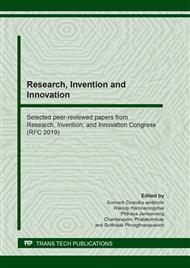[1]
R. Meyendorf, Nondestructive determination of case depth in surface hardened steels by combination of electromangetic test methods, (2011).
Google Scholar
[2]
S. Santa-aho, M. Vippola, A. Sorsa, K. Leiviska, M. Lindgren, T. Lepisto, Utilization of Barkhausen nosie magnetizing sweeps for case depth detection from hardened steel, NDT&E International. 52 (2012) 95-102.
DOI: 10.1016/j.ndteint.2012.05.005
Google Scholar
[3]
R. C. McMaster, Nondestructive testing handbook, The Ronald Press Company, New York, (1963).
Google Scholar
[4]
G. Dobmann, M. Kröning, W. Theiner, H. Willems, U. Fiedler, Nondestructive characterization of materials (ultrasonic and micromagnetic techniques) for strength and toughness prediction and the detection of early creep damage, Nucl. Eng. Des. 157 (1992) 137-158.
DOI: 10.1016/0029-5493(95)00992-l
Google Scholar
[5]
O. Kypris, I. C. Nlebedim, D. C. Jiles, Measuring stress variation with depth using Barkhausen signal, J. Magn. Magn. Mater. (2016) 377-395.
DOI: 10.1016/j.jmmm.2016.01.072
Google Scholar
[6]
T. L. Manh, F. Caleyo, J. M. Hallen, J. A. Perez Benitez, J. H. Espina Hernandez, Novel method for the accurate determination of magnetocrystalline energy from Barkhausen noise in ferromagnetic materials, Mater. Sci. Eng. (2017) 98-107.
DOI: 10.1016/j.mseb.2017.08.015
Google Scholar
[7]
N. Seemuang, T. Slatter, Using Barkhusen Noise to Measure Coating Depth of Coated haigh-speed steel, Int. J. Adv. Manauf. Technol. 92 (2017) 247-258.
DOI: 10.1007/s00170-017-0120-9
Google Scholar
[8]
B. D. Cullity, Introduction to magnetic materials, Addison-Wesley Publishing Company, Reading MA. (1972).
Google Scholar
[9]
M. Deveci, Nondestructive Determination of Case Depth by Barkhausen Noise Method, Tampere University of Technology, Tampere: Tampere University of Technology. (2016).
Google Scholar
[10]
A. Sorsa, Prediction of Material Properties Based on Non-destructive Barkhausen Noise Measurment. University of Oulu, Oulu: University of Oulu. (2013).
Google Scholar
[11]
C. Hucailuk, N. Nunez, D. Torres, Study by magnetic Barkhausen noise of a 1020 steel and 99.9% nickel plate, International Congress of Science and Technology of Metallurgy and Materials, SAM-CONAMET 2014. Puerto Iquazu, Argentina: Elsevier Procedia. (2015) 313-318.
DOI: 10.1016/j.mspro.2015.04.040
Google Scholar
[12]
D. M. Stewart, K. J. Stevens, A. B. Kaiser. Magnetic Barkhausen noise analysis of stress in steel, Curr. Appl. Phys. 4 (2004) 308-311.
Google Scholar
[13]
B. Augustyniak, L. Piotrowski, M. Chmielewski, K. Kosmas, E. Hristoforou. Barkhausen noise properties measured by different methods for deformed Armco samples, IEEE T Magn. 46 (2010) 544-547.
DOI: 10.1109/tmag.2009.2033340
Google Scholar
[14]
V. Moorthy, B. A. Shaw, Magnetic Barkhausen emission measurement for evaluation of depth of material properties in gears, NDT&E. (2008) 317-347.
Google Scholar
[15]
S. Santa-aho, Barkhausen noise method for hardened steel suface characterization - The effect of heat treatments, thermal damages and stresses, Tampere: Tampere University of Technology.(2012).
Google Scholar
[16]
M. Vashista and S. Paul, Novel processing of Barkhausen noise signal for assessment of residual stress in surface ground components exhibiting poor magnetic response, J. Magn. Magn. Mater. 323 (2011) 2579-2584.
DOI: 10.1016/j.jmmm.2011.05.036
Google Scholar
[17]
M. Dubois and M. Fiset, Evaluation of case depth on steels by Barkhausen noise measurements, Mater. Sci. Technol. 11 (1995) 264-267.
Google Scholar
[18]
A. Vaidyanathan, V. Moorthy, T. Jayakumar, B. Raj, Evaluation of induction hardened case depth throught microstructural characterization using magnetic Barkhausen noise emission technique, Mater Sci Technol. 16 (2000) 202-208.
DOI: 10.1179/026708300101507550
Google Scholar


